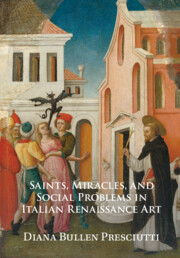Book contents
- Saints, Miracles, and Social Problems in Italian Renaissance Art
- Saints, Miracles, and Social Problems in Italian Renaissance Art
- Copyright page
- Contents
- Figures
- Acknowledgments
- One Introduction
- Two The Vita Icon Reimagined: New (and Old) Saints, New (and Old) Miracles
- Three Storytelling with Saints: Pictorial Narrative and Viewing Experience
- Four Girls in Trouble: Gendering Possession and Exorcism
- Five Assault, Amputation, Absolution: Visualizing the Power of Confession
- Six Thinking with Julian: Marital Violence and Elite Masculinity
- Seven Bernardino the Peacemaker: Visual Hagiography and Factional Violence
- Eight Cannibal Mothers: Picturing Madness and Maternal Infanticide
- Nine Making Innocence Visible (and Audible) in the Basilica del Santo
- Epilogue
- Bibliography
- Index
Seven - Bernardino the Peacemaker: Visual Hagiography and Factional Violence
Published online by Cambridge University Press: 14 April 2023
- Saints, Miracles, and Social Problems in Italian Renaissance Art
- Saints, Miracles, and Social Problems in Italian Renaissance Art
- Copyright page
- Contents
- Figures
- Acknowledgments
- One Introduction
- Two The Vita Icon Reimagined: New (and Old) Saints, New (and Old) Miracles
- Three Storytelling with Saints: Pictorial Narrative and Viewing Experience
- Four Girls in Trouble: Gendering Possession and Exorcism
- Five Assault, Amputation, Absolution: Visualizing the Power of Confession
- Six Thinking with Julian: Marital Violence and Elite Masculinity
- Seven Bernardino the Peacemaker: Visual Hagiography and Factional Violence
- Eight Cannibal Mothers: Picturing Madness and Maternal Infanticide
- Nine Making Innocence Visible (and Audible) in the Basilica del Santo
- Epilogue
- Bibliography
- Index
Summary
Among the miracles of St. Bernardino of Siena depicted in the so-called Niche of St. Bernardino is the violent assault and subsequent miraculous healing of one Giovanni Antonio Tornano (Fig. 100). The panel is one of eight tempera-on-panel miracle scenes that originally bordered a figure of St. Bernardino, probably a sculpture; the ensemble would have been installed in a highly visible location, such as the tramezzo (rood screen), in a church in Perugia, most likely the Franciscan friary of San Francesco al Prato.1 In the panel, Bernardino, with his trademark gaunt visage, appears at the bedside of the sleeping (or unconscious) Tornano. The saint heals the wounded man with his outstretched right hand. In the right foreground, we move back in time to witness the fateful attack: two blade-wielding men assault Tornano, accompanied by a pair of accomplices. Further afield, two additional men serve as witness figures, the one in green exhibiting shock at the violent events unfolding before his eyes. The compositional structure of the panel is thus split, with the attack shown in the right foreground and the miraculous healing in the left mid-ground. This pictorial strategy privileges the violent events over their resolution, with the viewer’s attention drawn away from the saint and his charge to the bright colors and graceful poses of the dynamic combatants.
- Type
- Chapter
- Information
- Saints, Miracles, and Social Problems in Italian Renaissance Art , pp. 221 - 257Publisher: Cambridge University PressPrint publication year: 2023



